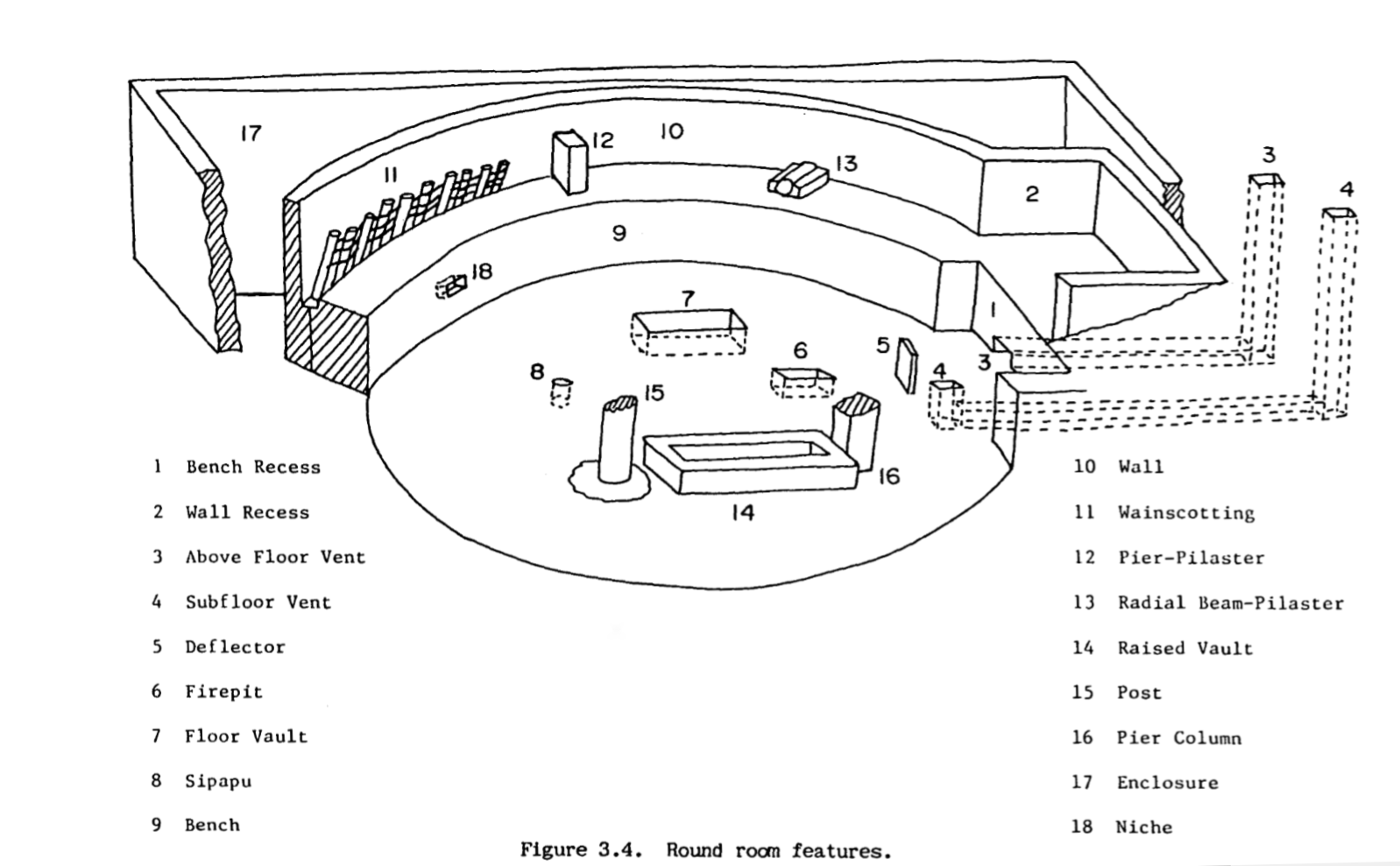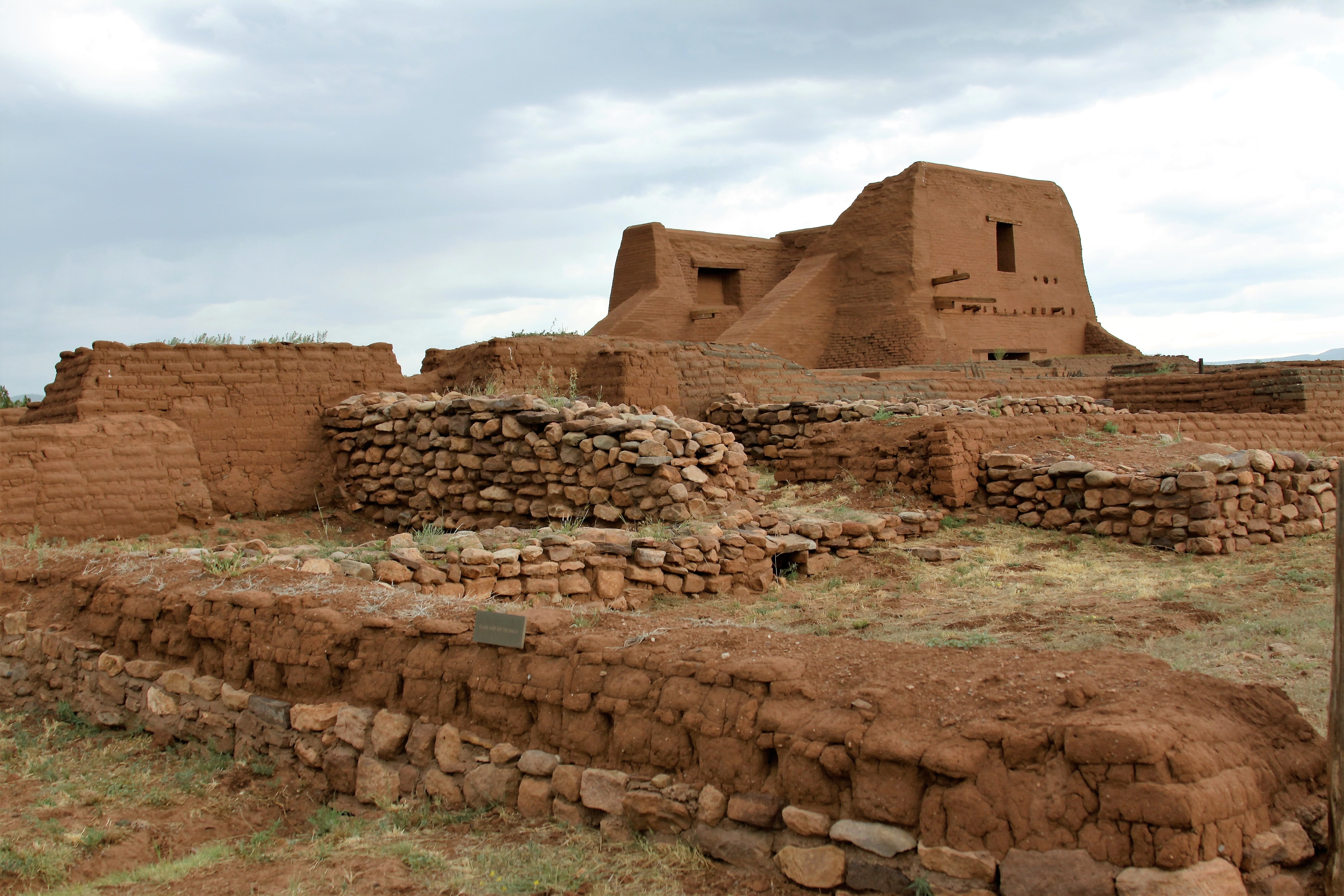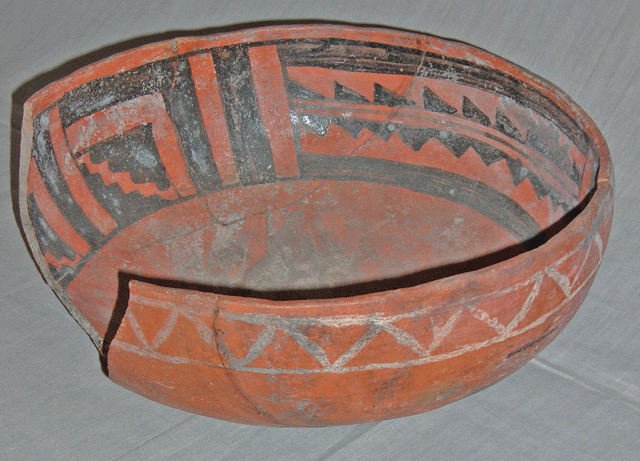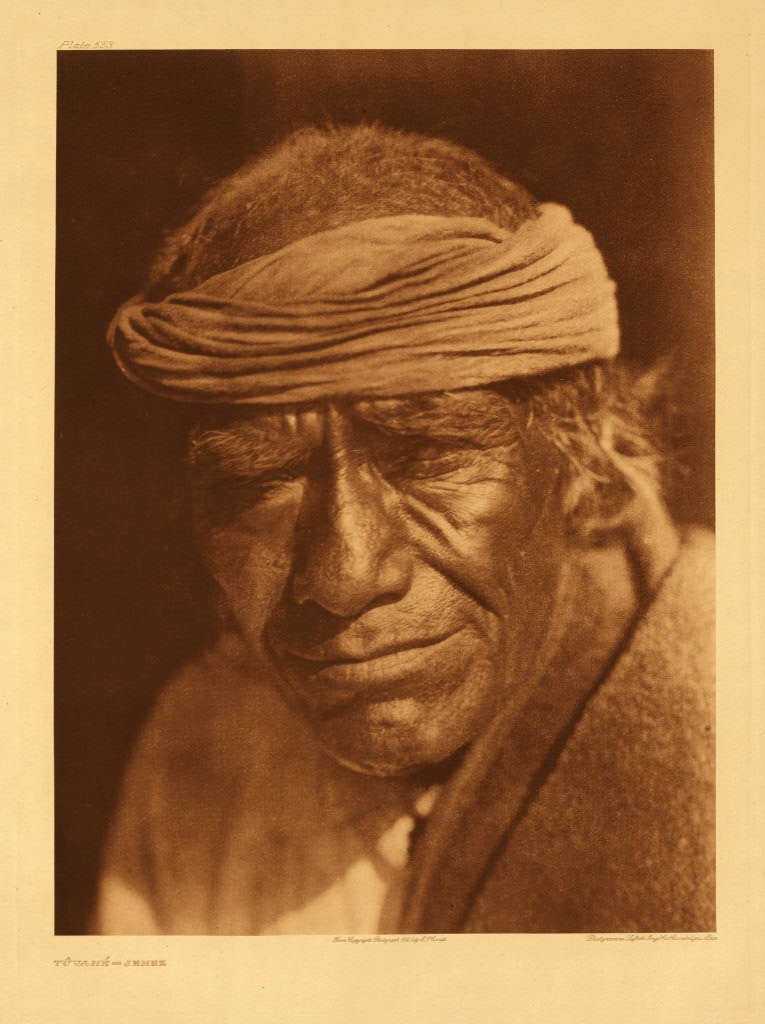|
Pecos National Monument
Pecos National Historical Park is a United States National Historical Park in San Miguel and Santa Fe Counties, New Mexico. The park, operated by the National Park Service, encompasses thousands of acres of landscape infused with historical elements from prehistoric archaeological ruins to 19th-century ranches, to a battlefield of the American Civil War. Its largest single feature is Pecos Pueblo also known as Cicuye Pueblo, a Native American community abandoned in historic times. First a state monument in 1935, it was made Pecos National Monument in 1965, and greatly enlarged and renamed in 1990. Two sites within the park, the pueblo and the Glorieta Pass Battlefield, are National Historic Landmarks. Features Pecos National Historical Park's main unit is located in western San Miguel County, about east of Santa Fe and just south of Pecos. Pecos Pueblo The main unit of the park preserves the ruins of Pecos Pueblo, known historically as Cicuye (sometimes spelled Ciquiq ... [...More Info...] [...Related Items...] OR: [Wikipedia] [Google] [Baidu] |
New Mexico State Road 63
State Road 63 (NM 63) is a state highway in the US state of New Mexico. Its total length is approximately . NM 63's northern terminus is a continuation as Cabana Trail in Cowles, and the southern terminus is at Interstate 25 (I-25), U.S. Route 84 (US 84) and US 85 in Rowe. Major intersections See also * List of state roads in New Mexico State roads in New Mexico, along with the Interstate Highway System, and the United States Numbered Highway System, fall under the jurisdiction of the New Mexico Department of Transportation (NMDOT). The U.S. state of New Mexico has 412 st ... References External links {{Attached KML, display=inline,title 063 Transportation in San Miguel County, New Mexico 063 ... [...More Info...] [...Related Items...] OR: [Wikipedia] [Google] [Baidu] |
Pueblo IV Era
The Pueblo IV Period (AD 1350 to AD 1600) was the fourth period of ancient pueblo life in the American Southwest. At the end of prior Pueblo III Period, Ancestral Puebloans living in the Colorado and Utah regions abandoned their settlements and migrated south to the Pecos River and Rio Grande valleys. As a result, pueblos in those areas saw a significant increase in total population. The Pueblo IV Period (Pecos Classification) is similar to the "Regressive Pueblo Period" or, referring to the Ancient Pueblo People of Colorado and Utah, the "Post Pueblo Period." It is preceded by the Pueblo III Period, and is followed by the present Pueblo V Era. Architecture Puebloan villages in Arizona and New Mexico had multi-storied pueblos of up to a thousand clustered rooms. The New Mexico villages were generally larger than those of western region, which had large plazas with long, rectangular kivas. Communities The great migration out of Colorado and Utah at the end of the Pueblo III ... [...More Info...] [...Related Items...] OR: [Wikipedia] [Google] [Baidu] |
Rodeo
Rodeo () is a competitive equestrian sport that arose out of the working practices of cattle herding in Spain and Mexico, expanding throughout the Americas and to other nations. It was originally based on the skills required of the working vaqueros and later, cowboys, in what today is the western United States, western Canada, and northern Mexico. Today, it is a sporting event that involves horses and other livestock, designed to test the skill and speed of the cowboys and cowgirls. American-style professional rodeos generally comprise the following events: tie-down roping, team roping, steer wrestling, saddle bronc riding, bareback bronc riding, bull riding and barrel racing. The events are divided into two basic categories: the rough stock events and the timed events. Depending on sanctioning organization and region, other events such as breakaway roping, goat tying, and pole bending may also be a part of some rodeos. The "world's first public cowboy contest" was held on Jul ... [...More Info...] [...Related Items...] OR: [Wikipedia] [Google] [Baidu] |
Tex Austin
Tex may refer to: People and fictional characters * Tex (nickname), a list of people and fictional characters with the nickname * Joe Tex (1933–1982), stage name of American soul singer Joseph Arrington Jr. Entertainment * ''Tex'', the Italian comic book series by Sergio Bonelli Editore * ''Tex'' (novel) (1979), by S.E. Hinton * ''Tex'' (film), a 1982 film based on S.E. Hinton's novel, starring Matt Dillon * Tex, the robot mascot for the American audio company THX Computing *TeX, a typesetting system created by Donald Knuth and released in 1978 **.tex, a file extension for TeX and LaTeX *Text Executive Programming Language, introduced by Honeywell in 1979 Other uses * TEX (explosive), an explosive chemical compound *Tex (unit), a unit of measure for the linear mass density of fibers *Nestlé Tex, a South African chocolate bar *IATA airport code for Telluride Regional Airport See also *Big Tex, the icon of the annual State Fair of Texas *Textainer Group Holdings, whose shippi ... [...More Info...] [...Related Items...] OR: [Wikipedia] [Google] [Baidu] |
Comanches
The Comanche or Nʉmʉnʉʉ ( com, Nʉmʉnʉʉ, "the people") are a Native American tribe from the Southern Plains of the present-day United States. Comanche people today belong to the federally recognized Comanche Nation, headquartered in Lawton, Oklahoma. The Comanche language is a Numic language of the Uto-Aztecan family. Originally, it was a Shoshoni dialect, but diverged and became a separate language. The Comanche were once part of the Shoshone people of the Great Basin. In the 18th and 19th centuries, Comanche lived in most of present-day northwestern Texas and adjacent areas in eastern New Mexico, southeastern Colorado, southwestern Kansas, and western Oklahoma. Spanish colonists and later Mexicans called their historical territory ''Comanchería''. During the 18th and 19th centuries, Comanche practiced a nomadic horse culture and hunted, particularly bison. They traded with neighboring Native American peoples, and Spanish, French, and American colonists and se ... [...More Info...] [...Related Items...] OR: [Wikipedia] [Google] [Baidu] |
Pueblo Revolt
The Pueblo Revolt of 1680, also known as Popé's Rebellion or Popay's Rebellion, was an uprising of most of the indigenous Pueblo people against the Spanish empire, Spanish colonizers in the province of Santa Fe de Nuevo México, larger than present-day New Mexico. The Pueblo Revolt killed 400 Spaniards and drove the remaining 2,000 settlers out of the province. The Spaniards reconquered New Mexico twelve years later. Background For more than 100 years beginning in 1540, the Pueblo people of present-day New Mexico were subjected to successive waves of soldiers, missionaries, and settlers. These encounters, referred to as ''entradas'' (incursions), were characterized by violent confrontations between Spanish colonists and Pueblo peoples. The Tiguex War, fought in the winter of 1540–41 by the expedition of Francisco Vásquez de Coronado against the twelve or thirteen pueblos of Tiwa Puebloans, Tiwa Native Americans, was particularly destructive to Pueblo and Spanish relations. In ... [...More Info...] [...Related Items...] OR: [Wikipedia] [Google] [Baidu] |
Kiva
A kiva is a space used by Puebloans for rites and political meetings, many of them associated with the kachina belief system. Among the modern Hopi and most other Pueblo peoples, "kiva" means a large room that is circular and underground, and used for spiritual ceremonies. Similar subterranean rooms are found among ruins in the North-American South-West, indicating uses by the ancient peoples of the region including the ancestral Puebloans, the Mogollon, and the Hohokam. Those used by the ancient Pueblos of the Pueblo I Period and following, designated by the Pecos Classification system developed by archaeologists, were usually round and evolved from simpler pit-houses. For the Ancestral Puebloans, these rooms are believed to have had a variety of functions, including domestic residence along with social and ceremonial purposes. Evolution During the late 8th century, Mesa Verdeans started building square pit structures that archeologists call protokivas. They were typ ... [...More Info...] [...Related Items...] OR: [Wikipedia] [Google] [Baidu] |
Francisco Vásquez De Coronado
Francisco is the Spanish and Portuguese form of the masculine given name ''Franciscus''. Nicknames In Spanish, people with the name Francisco are sometimes nicknamed "Paco". San Francisco de Asís was known as ''Pater Comunitatis'' (father of the community) when he founded the Franciscan order, and "Paco" is a short form of ''Pater Comunitatis''. In areas of Spain where Basque is spoken, "Patxi" is the most common nickname; in the Catalan areas, "Cesc" (short for Francesc) is often used. In Spanish Latin America and in the Philippines, people with the name Francisco are frequently called "Pancho". " Kiko" is also used as a nickname, and "Chicho" is another possibility. In Portuguese, people named Francisco are commonly nicknamed " Chico" (''shíco''). This is also a less-common nickname for Francisco in Spanish. People with the given name * Pope Francis is rendered in the Spanish and Portuguese languages as Papa Francisco * Francisco Acebal (1866–1933), Spanish writer and ... [...More Info...] [...Related Items...] OR: [Wikipedia] [Google] [Baidu] |
Spanish Missions In New Mexico
The Spanish Missions in New Mexico were a series of religious outposts in the Province of ''Santa Fe de Nuevo México'' — present day New Mexico. They were established by Franciscan friars under charter from the monarchs of the Spanish Empire and the government of the Viceroyalty of New Spain in a policy called Reductions to facilitate the conversion of Native Americans into Christianity. History They attempted to Hispanicize the indigenous peoples. The affected included the rich cultures and tribes of: many of the 21 distinct Puebloan groups; the Tiwa; the Navajo; and the Apache. The missions also aimed to pacify resistance to the European invasion of the tribes' Pre-Columbian homelands and loss of traditions. The missions introduced European livestock, fruits, vegetables, and small-scale industry into the Southwest region. They also introduced European diseases to which native people had little or no acquired immunity. Fray Marcos de Niza, sent by Coronado, first saw ... [...More Info...] [...Related Items...] OR: [Wikipedia] [Google] [Baidu] |
Mission Nuestra Señora De Los Ángeles De Porciúncula De Los Pecos
:''Another mission that bore the name Nuestra Señora Reina de los Ángeles is the former Nuestra Señora Reina de los Angeles Asistencia, Nuestra Señora Reina de los Ángeles Asistencia in Los Angeles, California.'' The Mission Nuestra Señora de los Ángeles de Porciúncula ("Mission of Our Lady of the Angels of Porciúncula") was a mission that served the people of the Pecos Pueblo, near modern Pecos, New Mexico, from sometime around 1619. The first church at the Pecos Pueblo was probably built by the Franciscan Fray Pedro Zambrano Ortiz by 1619, an isolated building on a narrow ridge about northeast of the pueblo's main quadrangle. The people of the pueblo would not allow construction of a church closer to their dwellings. In 1625, a more permanent church was constructed outside the walls of the pueblo of Pecos, New Mexico. The church building was destroyed in the Pueblo Revolt of 1680, wherein the Spanish were ejected from New Mexico. After the Spanish reconquest in 1693, ... [...More Info...] [...Related Items...] OR: [Wikipedia] [Google] [Baidu] |
Rio Grande Glaze Ware
Rio Grande Glaze Ware is a late prehistoric and historic pottery tradition of the Puebloan peoples of New Mexico. The tradition involved painting pots with black paint made with lead ore; as the pots were fired the black paint fused and sometimes ran. The tradition lasted from AD 1315 to 1700. Rio Grande Glaze Ware was made or used in a number of villages from the Santa Fe area to the north end of Elephant Butte Reservoir, and from the valley of the Rio Puerco east to the upper Pecos River Valley. Archaeologists divide Rio Grande Glaze Ware into arbitrary types with much shorter life spans, primarily to help them date sites. Individual potsherds are assigned to types based on a combination of attributes, beginning with vessel rim profiles and proceeding to painted designs or vice versa. Overview and cautions Rio Grande Glaze Ware was first made about AD 1315 (based on tree-ring dating at Tijeras Pueblo). It partly displaced an earlier tradition of black-on-white pottery and was ... [...More Info...] [...Related Items...] OR: [Wikipedia] [Google] [Baidu] |
Jemez Pueblo
Jemez Pueblo (/ˈhɛmɛz/; tow, Walatowa, nv, Mąʼii Deeshgiizh) is a census-designated place (CDP) in Sandoval County, New Mexico, United States. The population was 1,788 at the 2010 census. It is part of the Albuquerque Metropolitan Statistical Area. The CDP is named after the pueblo at its center. Among Pueblo members, it is known as . Geography Jemez Pueblo is located at (35.610435, -106.727509). According to the United States Census Bureau, the CDP has a total area of , all land. Demographics It seems that a significant part of the Jemez Pueblo population originates from the surviving remnant of the Pecos Pueblo population who fled to Jemez Pueblo in 1838. The Jemez speak a Kiowa–Tanoan language also known as '' Jemez'' or ''Towa.'' As of the census of 2000, there were 1,953 people, 467 households, and 415 families residing in the CDP. The population density was 957.0 people per square mile (369.6/km2). There were 499 housing units at an average density of 244.5 ... [...More Info...] [...Related Items...] OR: [Wikipedia] [Google] [Baidu] |
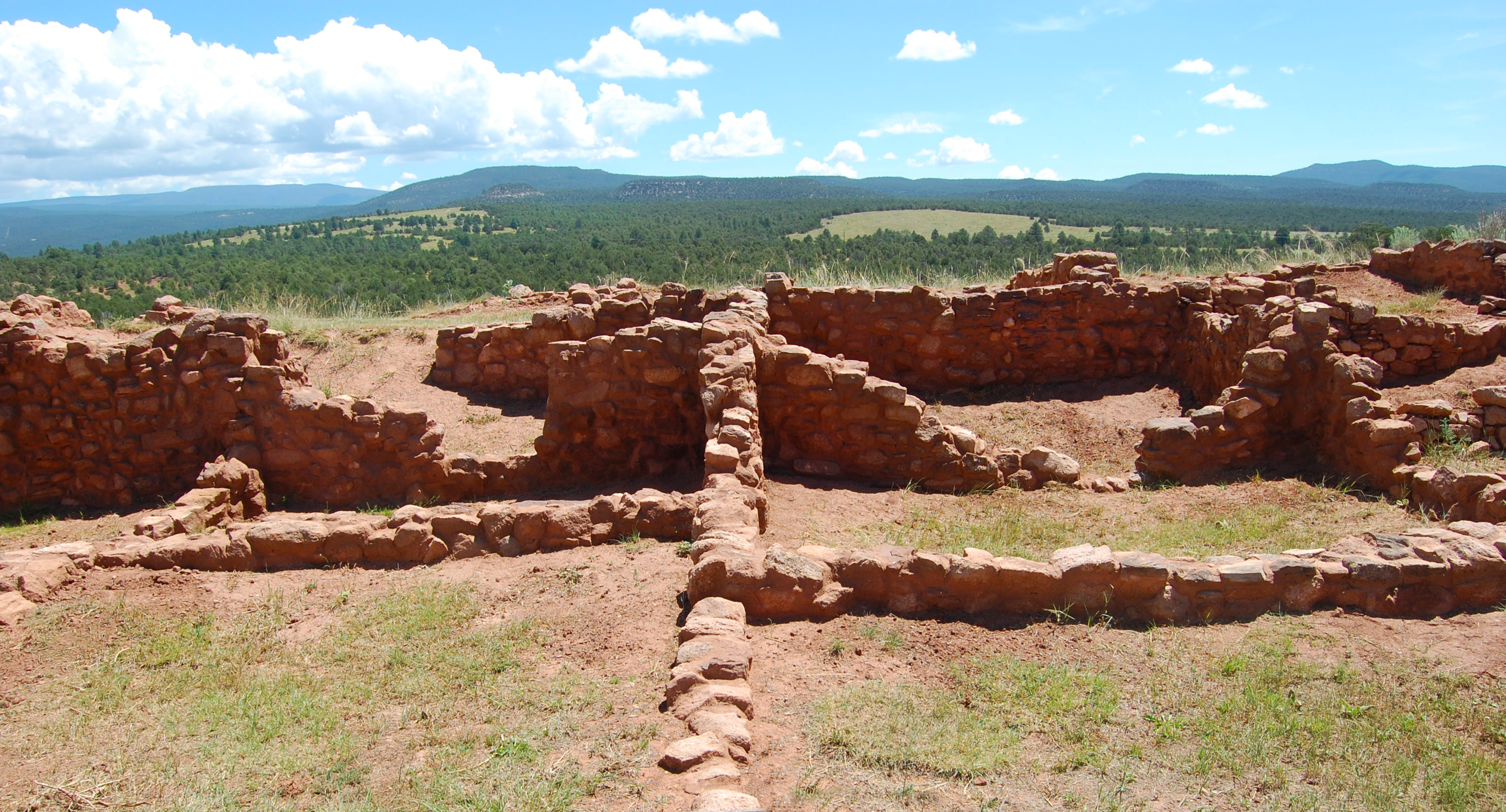
.jpg)

